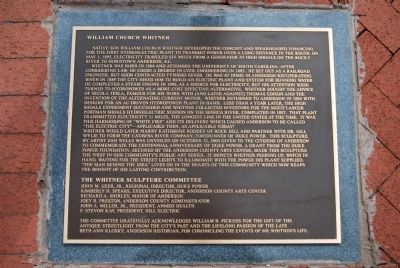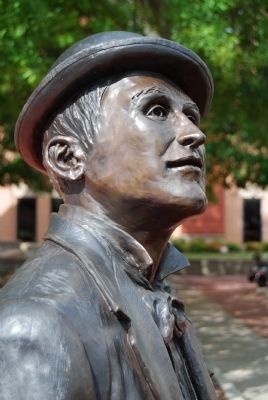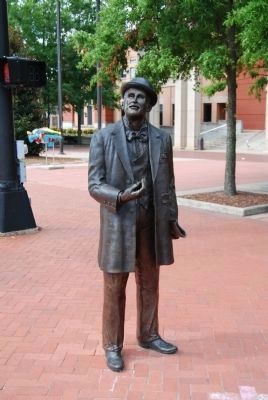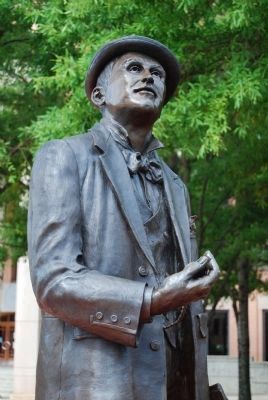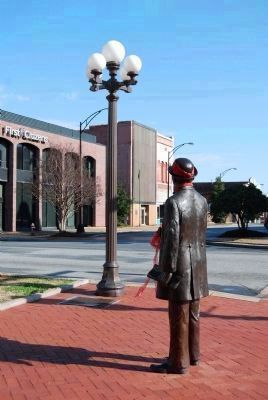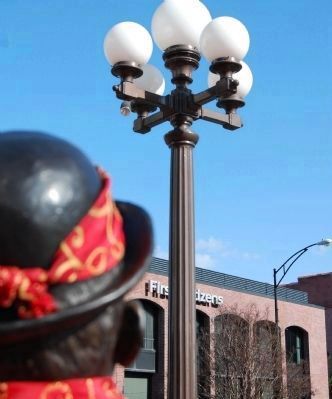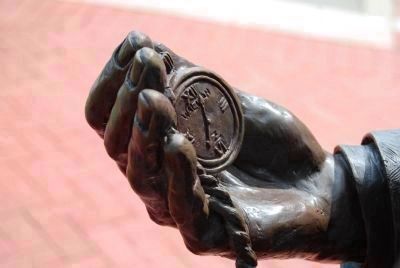Anderson in Anderson County, South Carolina — The American South (South Atlantic)
William Church Whitner
Centennial Anniversary of Duke Power
Native son William Church Whitner developed the concept and spearheaded financing for the first hydroelectric plant to transmit power over a long distance in the South. On May 1, 1895, electricity travelled six miles from a generator at High Shoals on the Rocky River to downtown Anderson, S.C.
Whitner was born in 1864 and attended the University of South Carolina. After considering law, he chose a degree in Civil Engineering in 1885. He set out as a railroad engineer, but soon contracted typhoid fever. He was at home in Anderson recuperating when in 1889 the city hired him to build an electric plant and system for running water. He completed a steam engine in 1890, as a source for electricity, but his attention soon turned to hydropower as a more cost effective alternative. Whitner sought the advice of Nicola Tesla, famous for his work with (and later against) Thomas Edison and the invention of the alternating current motor. Whitner returned to Anderson in 1894 with designs for an AC-driven hydropower plant in hand. Less than a year later, the High Shoals Experiment succeeded and Whitner collected investors for the much larger Portman Shoals Hydroelectric Station on the Seneca River, completed in 1897. That plant transmitted electricity 11 miles, the longest line in the United States at that time. It was this harnessing of "white fire" and its delivery which caused Anderson to be called "The Electric City" -- applicable then, as applicable today!
Whitner would later marry Katherine Roddey of Rock Hill and partner with Dr. Gill Wylie to form the Catawba River Company, forerunner of Duke Power. This sculpture by artist Zan Wells was unveiled on October 12, 2004. Given to the citizens of Anderson to commemorate the centennial anniversary of Duke Power. A grant from the Duke Foundation, secured by the Anderson County Arts Center, made this sculpture the first in our community's Public Art Series. It depicts Whitner peering up, watch in hand, waiting for the street lights to illuminate with the power his plant supplied. "The Man Behind the Idea" lives on in the hearts of this community which now reaps the benefit of his lasting contribution.
The Whitner Sculpture Committee
John M. Geer, Jr., Regional Director, Duke Power
Kimberly H. Spears, Executive Director, Anderson Arts Center
Richard A. Shirley, Mayor of Anderson
Joey R. Preston, Anderson County Administrator
John A. Miller, Jr., President, ANMED Health
F. Stevon Kay, President, Hill Electric
The committee gratefully acknowledges William B. Pickens for the gift of the Antique Streetlight from the city's past and the lifelong passion of the late Beth Ann Klosky, Anderson Historian, for chronicling the events of Mr. Whitner's life.
Erected 2004 by Duke Power, City and County of Anderson, and Anderson Arts Center.
Topics. This historical marker is listed in these topic lists: Industry & Commerce • Science & Medicine. A significant historical month for this entry is May 1861.
Location. 34° 30.196′ N, 82° 39.012′ W. Marker is in Anderson, South Carolina, in Anderson County. Marker is on Main Street. Marker is located on the grounds of the New County Courthouse, northwest corner. Touch for map. Marker is in this post office area: Anderson SC 29621, United States of America. Touch for directions.
Other nearby markers. At least 10 other markers are within walking distance of this marker. Anderson County Court House -- 1898 (a few steps from this marker); Anderson: "The Electric City" (a few steps from this marker); Anderson County Confederate Monument (a few steps from this marker); Anderson County Law Enforcement Officers Memorial (within shouting distance of this marker); The Four Way Test (within shouting distance of this marker); Fant's Book Store -- 1851 (within shouting distance of this marker); Sullivan Hardware Co. -- 1875 (about 300 feet away, measured in a direct line); Bank of Anderson Building - ca. 1891 (about 300 feet away); Blue Ridge Railroad Passenger Station -- c. 1913 (about 300 feet away); Masonic Temple -- 1889 (about 400 feet away). Touch for a list and map of all markers in Anderson.
Regarding William Church Whitner. Power was transmitted first to the Anderson Cotton Mill. In the 1990s, the mill closed. It has been damaged by fire in 2005 and twice in 2007.
Additional commentary.
1. High Shoals
It was in 1890 that W.C. Whitner first lit Anderson with 750 incandescent lamps, using steam power to generate the electricity. Until Whitner's early experiments with high voltage power production at High Shoals in 1894 and the construction of the highly successful Portman plant using methods developed at High Shoals, electricity was produced in extremely low voltage at the site of its use, usually in steam plants. Whitner was convinced that high voltage electricity could be carried some distance and wanted from the first to build a plant at Portman Shoals but could not convince his company of the feasibility of his plan nor was the Anderson Cotton Mill ready at that time to make the contract for electric power to operate the mill, a condition necessary in so large an undertaking. However, being authorized to try the long distance transmission on a smaller scale, Mr. Whitner leases High Shoals, only six miles from Anderson, and there, using the mill's waterpower, he developed and successfully transmitted 200 electrical horsepower. The number of incandescent lights in the town was increased to 2,000 and 70 arc lights were put in. The large pumps at the waterworks were operated by this power, and the balance was distributed to various smaller industries in the city. Soon the Anderson Cotton Mill decided to use electric power rather than steam, and many other industries began doing the same. The company, deciding to develop the power at Portman Shoals, reorganized as the Anderson Light and Power Company and began construction of the plant on the Seneca River. (Source: Sketches of Anderson County, The Anderson Tricentennial Committee, 1969.)
— Submitted January 9, 2009, by Brian Scott of Anderson, South Carolina.
Credits. This page was last revised on October 14, 2020. It was originally submitted on August 24, 2008, by Brian Scott of Anderson, South Carolina. This page has been viewed 4,167 times since then and 231 times this year. Photos: 1, 2, 3, 4. submitted on August 24, 2008, by Brian Scott of Anderson, South Carolina. 5. submitted on January 1, 2009, by Brian Scott of Anderson, South Carolina. 6. submitted on January 9, 2009, by Brian Scott of Anderson, South Carolina. 7. submitted on August 24, 2008, by Brian Scott of Anderson, South Carolina. • Kevin W. was the editor who published this page.
